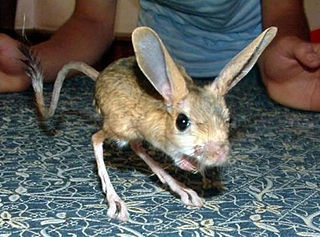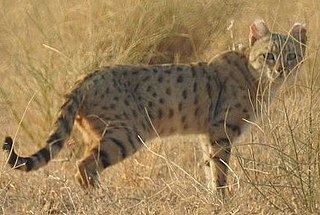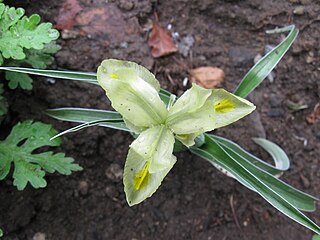
Jerboas are hopping desert rodents found throughout North Africa and Asia, and are members of the family Dipodidae. They tend to live in hot deserts.

The four-toed jerboa is a rodent of the family Dipodidae and genus Scarturus that has four digits. Four-toed jerboas are native to Egypt and Libya. They live in coastal salt marshes and dry deserts.

Dipodoidea is a superfamily of rodents, also known as dipodoids, found across the Northern Hemisphere. This superfamily includes over 50 species among the 16 genera in 3 families. They include the jerboas, jumping mice, and birch mice. Different species are found in grassland, deserts, and forests. They are all capable of saltation, a feature that is most highly evolved in the desert-dwelling jerboas.

The long-eared hedgehog is a species of hedgehog native to Central Asian countries and some countries of the Middle East. The long-eared hedgehog lives in burrows that it either makes or finds and is distinguished by its long ears. It is considered one of the smallest Middle Eastern hedgehogs. This hedgehog is insectivorous but may also feed on small vertebrates and plants. In captivity they can live for over 7 years.

The genus Allactaga contains the five-toed jerboas of Asia. They are small mammals belonging to the order of rodents. They are characteristically known as the hopping rodents of the desert and semi-arid regions. They have long hind feet, short forelimbs, and walk upright. They have large ears in comparison to their body size and a large tail. The tail assists and serves as support when the jerboa is standing upright. The jerboa body length ranges from 5–15 cm and has a tail ranging from 7–25 cm. The "forelimbs of the jerboa serve as a pair of hands for feeding, grooming, etc." Jerboas use their nose to burrow and push the dirt when looking for food. The male jerboa is usually larger in size and weight in comparison to the female jerboa. The pelt of the jerboa is either silky or velvety in texture and light in color, the coloration helps camouflage into surroundings to avoid predators. All members of the genus have five toes except for a single species, the Four-toed Jerboa, Allactaga tetradactyla of Northern Africa.

The Asiatic wildcat, also known as the Asian steppe wildcat and the Indian desert cat, is an African wildcat subspecies that occurs from the eastern Caspian Sea north to Kazakhstan, into western India, western China and southern Mongolia. There is no information on current status or population numbers across the Asiatic wildcat's range as a whole, but populations are thought to be declining.
The Iranian jerboa is a rodent of the family Dipodidae and subfamily Allactaginae. They are characteristically known as hopping rodents and have only been found in a small population in Iran. Iranian jerboa are microhabitat specialist, they require a particular environment to provide them with specific conditions suitable for living.

Panthera pardus tulliana is a leopard subspecies native to the Iranian Plateau and surrounding areas encompassing Turkey, the Caucasus, Azerbaijan, Georgia, Armenia, Iraq, Iran, Turkmenistan, Afghanistan and possibly Pakistan. Since 2016, it has been listed as Endangered on the IUCN Red List, as the wild population is estimated at less than 1,000 mature individuals.

The wildlife of Azerbaijan consists of its flora and fauna and their natural habitats.
The Gobi jerboa is a species of rodent in the family Dipodidae. It is found in China and Mongolia. Its natural habitats are temperate grassland and temperate desert.

The small five-toed jerboa is a rodent of the family Dipodidae and genus Scarturus, that has five digits. They are hopping rodents of the rocky deserts in Asia. They have been found in Afghanistan, Armenia, Azerbaijan, China, Georgia, Iran, Kazakhstan, Pakistan, Russia, Tajikistan, Turkey, and Turkmenistan. They have long hind feet, short forelimbs, and walk upright. The jerboa body length ranges from 5–15 cm and has a tail ranging from 7–25 cm. They have large ears in comparison to their body size and a large tail. The tail assists and serves as support when the jerboa is standing upright. These hopping rodents can reach a speed up to 48 km/hr. The forelimbs of the jerboa serve as a pair of hands for feeding, grooming, etc. The male jerboa is usually larger in size and weight in comparison to the female jerboa. The pelt of the jerboa is either silky or velvety in texture and light in color, the coloration helps camouflage into surroundings to avoid predators. "Its coloration varies from sandy or buff to dark russet or black with pale under parts and a white strip on the hip”.
The Euphrates jerboa is a rodent of the family Dipodidae and genus Scarturus. They are characteristically known as hopping rodents. They have been found in Pakistan, Afghanistan, Iran, Iraq, Jordan, Kuwait, Saudi Arabia, Syria, and also occurs very marginally in southeastern Turkey. The Euphrates jerboa's natural habitats are semi-deserts, subtropical or tropical dry lowland grassland and hot deserts.
Hotson's jerboa or the Iranian jerboa, is a species of rodent in the family Dipodidae. It is found in Afghanistan, Iran, and Pakistan.

The Asia Minor ground squirrel, also known as Anatolian souslik, Anatolian ground squirrel, is a species of rodent in the family Sciuridae. It is found in Armenia, Iran, and Turkey. The scientific name roughly translates as "seed-lover with yellow underparts".

Bayat is one of the Oghuz tribes in Turkmenistan, Iran, Turkey, Azerbaijan, Iraq, Afghanistan, and Syria. When Oghuz Turks started to migrate from the Aral steppes to Khorasan in the 11th and 13th centuries, Bayat people spread throughout the region. They are sub-ethnic groups of Turkmens and Azerbaijanis. Bayats are Muslim and speak a southern dialect of Azerbaijani language in Azerbaijan and Iran, or their own dialect of Turkish in Turkey, and Ersari dialect of Turkmen in Turkmenistan and Uzbekistan. The ancient Turkmen proverb says: "Kayi and Bayat tribes shall lead the people".

Iris pseudocaucasica is a species in the genus Iris, it is also in the subgenus Scorpiris. It is a bulbous perennial from central Asia, within the Caucasus and in Iran, Iraq and Turkey.

The Central Anatolian steppe is a Palearctic ecoregion in the temperate grasslands, savannas, and shrublands biome. It covers an area of 24,934 km2.













